What type of art was created during the Bauhaus art movement?
Architecture, installations, painting and print artwork were produced during the Bauhaus art movement.
Bauhaus was created and popular during which years?
1919 to 1933 is when the Bauhaus art movement was most popular. This movement was named after the Bauhaus art school in Germany However, there is currently a resurgence in graphic design.
Where was Bauhaus made and popularised?
Bauhaus began in Germany at the Bauhaus art school which had just 500 students graduate during its tenure. Later on, the movement spread to other parts of Europe, Russia, Israel, Switzerland and even the USA.
What medium (media) and tools were used to make Bauhaus pieces?
Wood, metal and building materials and digital art
Who are some famous Bauhaus artists and artworks?
Wall Hanging by Anni Albers,
Homage to the Square: Apparition by Josef Albers
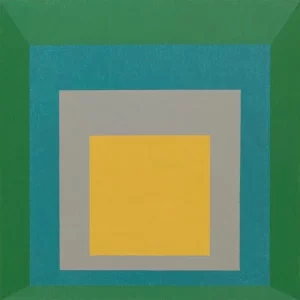
Ship Building Toy by Alma Siedhoff-Buscher
Interesting observations about Bauhaus Art
What started as a building in Germany, went on to influence print art and installations and today, it inspires a digital design aesthetic. If composed right, Bauhaus is one of those aesthetic styles that can comply with almost any art or design medium. What is more is that the straight lines, curved edges, tinted colours and overall language of composition, Bauhaus art is easily recognisable.
Walter Gropius began this movement with the fundamental belief that in art there must be no distinction between form and function. For example, this would mean that the shape of a wall and the function of a wall should be singular. In other words, if ornamentation did not serve a purpose or function, it did not need to be there. This is why Bauhaus art can be described as “to the point.”
Which art movement(s) came before the Bauhaus movement?
Cubism, Art Deco, Suprematism and Constructivism came before or during the Bauhaus art movement.
Which art movement(s) came after the Bauhaus movement?
Abstract Expressionism and Pop Art came at the time when the Bauhaus art movement was coming to an end.
Top 10 artworks of the Bauhaus Art Movement:
The Bauhaus Building in Dessau by Walter Gropius

The Bauhaus movement found its physical manifestation in the iconic Bauhaus Building in Dessau, designed by the movement’s founder, Walter Gropius. Completed in 1926, this architectural masterpiece became a symbol of modernist ideals. Gropius envisioned a space where art, design, and craftsmanship could seamlessly converge. The building tells of Gropius’s relentless pursuit of unity in design, reflected in the building’s clean lines and functional form. The Bauhaus Building not only housed the institution but embodied the revolutionary spirit of the Bauhaus movement.
The Bauhaus Emblem by Oskar Schlemmer
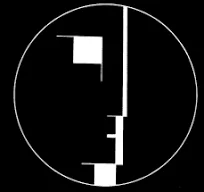
Oskar Schlemmer, a master at the Bauhaus, designed the iconic Bauhaus emblem in 1922. The emblem, a bold, geometric arrangement of squares, circles, and triangles to form a face encapsulated the school’s principles. This was Schlemmer’s intent to create a symbol representing the synthesis of art and technology. The emblem, like the Bauhaus itself, became a visual manifesto, illustrating the movement’s commitment to a harmonious union of form and function.
Poster for the 1923 Bauhaus Exhibition in Weimar by Joost Schmidt
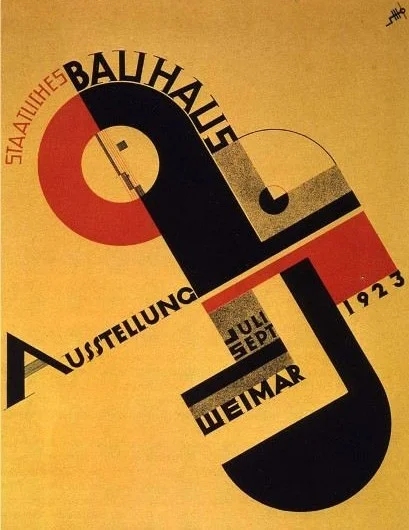
Joost Schmidt’s poster for the 1923 Bauhaus Exhibition in Weimar is a visual testament to the avant-garde spirit of the movement. Schmidt, a Bauhaus student and later a teacher, crafted a design that transcended traditional poster conventions. Anecdotes suggest that Schmidt aimed to evoke curiosity and challenge conventional perceptions of art. The poster, with its dynamic typography and abstract composition, not only promoted the exhibition but became a landmark in graphic design, influencing generations to come.
Homage to the Square: Temperate by Josef Albers
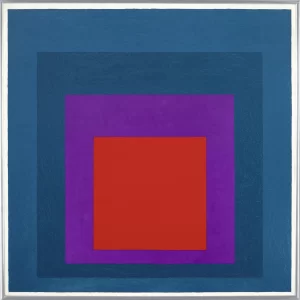
Josef Albers, a prominent figure at the Bauhaus, explored the interplay of colour and form in his series “Homage to the Square.” “Temperate,” an exemplary piece from this series, is an exploration of the optical effects of colour interactions. This series shows Albers’s experienced use of colour theory and his fascination with how colours could create different spatial illusions. “Homage to the Square: Temperate” stands as a testament to Albers’s lifelong dedication to understanding the nuances of colour and its impact on perception.
Wall Hanging by Anni Albers 1926
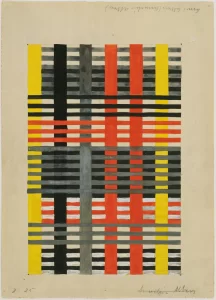
Anni Albers, wife of Josef Albers, made significant contributions to the Bauhaus movement, particularly in the realm of textile arts. Her wall hanging from 1926 exemplifies her innovative approach to weaving and design. This piece highlights Anni’s experimental spirit, constantly pushing the boundaries of traditional craftsmanship. The wall hanging, with its geometric patterns and use of materials, reflects Anni’s belief in the transformative power of textiles as a medium for artistic expression.
Vertiefte Regung by Wassily Kandinsky
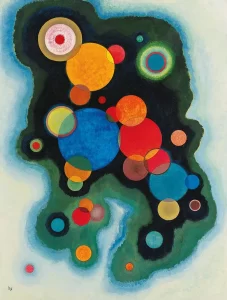
“Vertiefte Regung” or “Deepened Impulse” by Wassily Kandinsky is a testament to the artist’s journey into abstraction. Kandinsky’s spiritual approach to art, with “Vertiefte Regung” is a visual representation of his deepened emotional and intellectual state. Kandinsky believed that art had the power to evoke profound emotions, and this painting, with its vibrant colours and dynamic forms, is a manifestation of his quest to tap into the spiritual essence of creativity.
Upward by Wassily Kandinsky
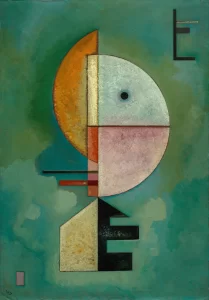
“Upward” is another captivating piece by Kandinsky, reflecting his fascination with the cosmic and spiritual dimensions of art. This artwork suggests that Kandinsky saw art as a means of transcending the material world and connecting with higher realms of consciousness. “Upward,” with its soaring forms and celestial palette, is an exploration of the artist’s inner visions and his belief in the transformative potential of abstract art.
Contrasting Sounds by Wassily Kandinsky
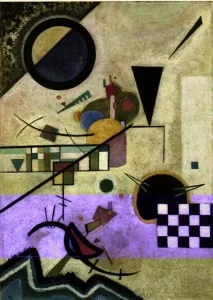
Kandinsky’s “Contrasting Sounds” is a symphony of colour and form. This piece implies Kandinsky’s synesthetic experiences, where he perceived colours and shapes in response to musical stimuli. “Contrasting Sounds” is an attempt to capture the dynamic energy and harmonies he associated with music. Kandinsky’s dedication to expressing the ineffable through visual art is evident in this masterpiece.
Bauhaus Stairway by Oskar Schlemmer
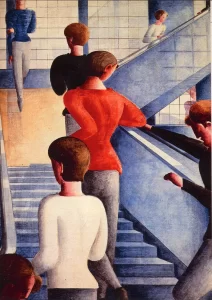
Oskar Schlemmer’s “Bauhaus Stairway” is a theatrical exploration of space and movement. The painting reveals Schlemmer’s interest in choreography and his belief in the synthesis of the performing arts with architecture. The painting portrays figures engaged in a rhythmic dance on a geometric staircase, embodying the Bauhaus spirit of interdisciplinary collaboration and the integration of art into everyday life.
Ship Building Toy by Alma Siedhoff-Buscher

Alma Siedhoff-Buscher, one of the few women at the Bauhaus, designed the Ship Building Toy in 1923. This toy celebrates Siedhoff-Buscher’s innovative approach to children’s toys, emphasising simplicity and creativity. The ship-building set, with its modular wooden pieces, encouraged imaginative play and reflected Bauhaus ideals of being functional and accessible for all.
The Bauhaus movement’s legacy is rich with anecdotes of artistic experimentation, collaboration, and a commitment to redefining the boundaries of creativity. These ten iconic artworks stand as timeless symbols of the Bauhaus ethos, where art, design, and craftsmanship converged to shape the course of modern art history.
*Images from Wiki Commons







0 Comments